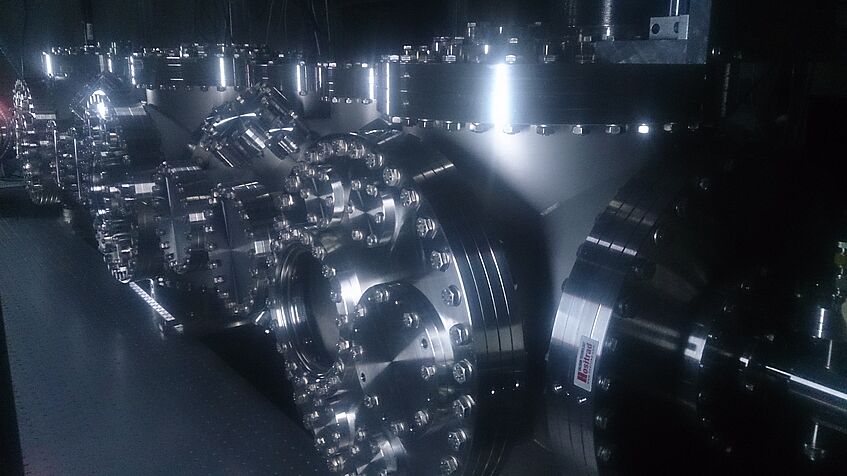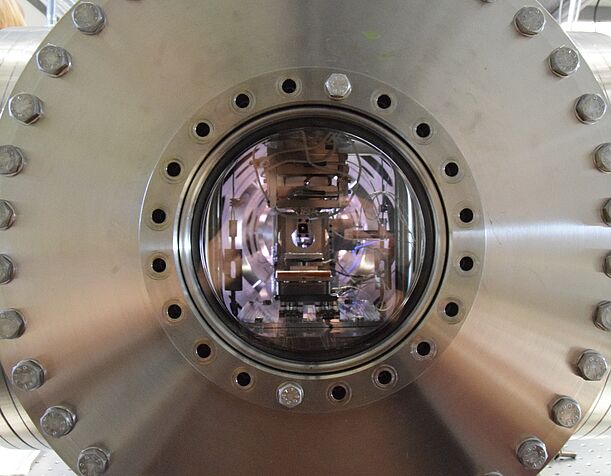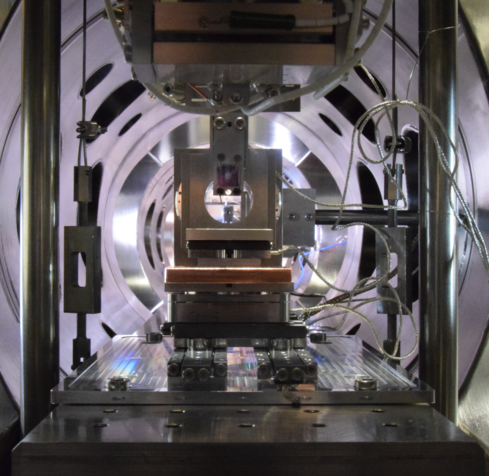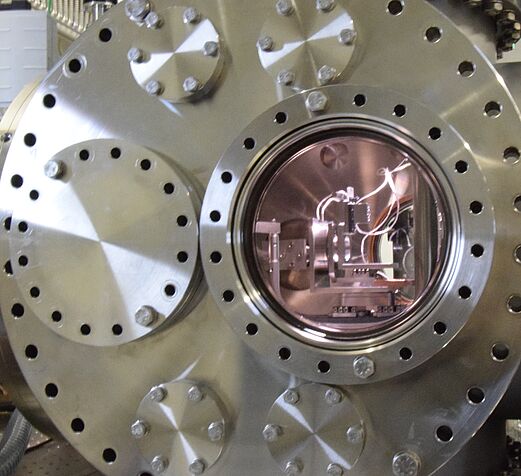Long baseline Universal Matter-wave Interferometer (LUMI)
LUMI is based on the KDTLI concept and is distinguished from it by the 10x increased length, here to 2 m interferometer length. This increases the acceptance of high mass even at high velocity and with that also de Broglie wavelengths of smaller than 50 fm. In this setup we have established new records in quantum macroscopicity and boosted the metrological sensitivity to forces below 10-26 N.
As of today, LUMI is the only matter-wave interferometer capable of demonstrating interference of particles beyond 25 000 atomic mass units, here a family of tailored oligoporphyrins[1].
Like the KDTLI and OTIMA experiments, LUMI relies on the Talbot-Lau effect, because near-field interference offers a good mass scalability and signal throughput. LUMI has the unique capability to be operated in two different modes.
- KDTLI mode: For slow, polarizable molecules we use a nano-mechanical gratings (d = 266 nm) in position G1 and G3 to act as transmission mask for coherence preparation and fringe detection, respectively. The central phase grating G2 is formed by a green standing light wave.
- TLI mode: For fast particles of low polarizability, the second grating G2 can also swapped in-vacuum for a nano-mechanical grating, identical to those in G1 and G3.
This interchangeability enables improved metrology of molecular properties, since it allows the device to be calibrated with atoms, whose properties are typically better understood.
Sources
LUMI 1.0 was calibrated using thermal sources and EI-QMS mass spectrometry, which are both established and reliable methods for thermally stable molecules in the mass range up to several kDa. It was extended to a laser desorption source for high-mass interferometry. The upgrade, LUMI 2.0 will be connected to a metal cluster source.
Inertial and Vibrational Phase Averaging
The long baseline endows the instrument with high sensitivity to external forces, in particular also to vibrations and to the Coriolis shift caused by the rotation of the Earth. Earth's gravity imposes also stricter alignment requirements than in all previous molecule interferometers. We have found, however, that the gravitational and Coriolis shift can compensate each other in a suitable alignment of the interferometer.
To address the vibrational sensitivity, we have mounted the interferometer on a high-mass (160 kg) INVAR bar suspended from a double pendulum. Springs, teflon balls, and eddy damping brakes provide additional vibrational isolation and damping. A piezo accelerometer on the interferometer bar as well as an optical Mach-Zehnder interferometer operated in parallel with the molecular interferometer give precise readout of grating motions and can also be used in an active feedback scheme.
Grating control
Nanometer-precision SMARACT© piezo motors control shift, roll, and longitudinal displacement of the gratings in LUMI. They allow excellent alignment, reproducibility and a travel range sufficient to interchange material and optical gratings in situ.
Detection
LUMI 1.0 is equipped with a quadrupole mass spectrometer (QMS) with a cross beam deflector for high-mass resolution with low dark counts and high transmission. The entire detector can be lifted out of the beam-line in favor of other detection methods, such as laser post-ionization TOF-MS or fluorescence imaging.
Successful completion
The experiment was setup, completed and confirmed the wave-particle duality for particles as massive as 25 kDa. This also sets new interferometric bounds on the possibility of wavefunction collapse.
The high force sensitivity has been utilized to measure improved of first polarizabilities of organic molecules, as well as diamagentism in atoms and molecules.
Follow-up
The experiment is now being upgraded to LUMI 2.0, which will substitute all gratings with optical photo-depletion gratings to extend the mass range to several 100 000 amu, using metal clusters.
A key challenge in future experiments with biomolecules is the development of soft beam methods for fragile molecules. These are currently also being developed within the EU project SuperMaMa.
References:
- Y.Y. Fein, A. Shayeghi, F. Kiałka, P. Geyer, S. Gerlich, and M. Arndt,
Quantum-assisted diamagnetic deflection of molecules
Phys. Chem. Chem. Phys. 22, 14036 (2020), 10.1039/d0cp02211j, PCCP Hot Paper - Y.Y. Fein, A. Shayeghi, L. Mairhofer, F. Kialka, P. Rieser, P. Geyer, S. Gerlich, M. Arndt
https://journals.aps.org/prx/abstract/10.1103/PhysRevX.10.011014Quantum-Assisted Measurement of Atomic Diamagnetism,
Phys. Rev. X 10, 011014 (2020). DOI 10.1103/PhysRevX.10.011014 - Y.Y. Fein, F. Kialka, P. Geyer, S. Gerlich, M. Arndt
Coriolis compensation via gravity in a matter-wave interferometer,
New J. Phys. (2020). DOI 10.1088/1367-2630/ab73c5 - Y. Y. Fein, P. Geyer, F. Kiałka, S. Gerlich, and M. Arndt,
Improved accuracy fullerene polarizability measurements in a long-baseline matter-wave, interferometer,
Physical Review Research 1, 033158 (2019). - Y. Y. Fein, P. Geyer, P. Zwick, F. Kiałka, S. Pedalino, M. Mayor, S. Gerlich, and M. Arndt,
Quantum superposition of molecules beyond 25 kDa,
Nature Physics 15, 1242 (2019). - F. Kiałka, B. Stickler, K. Hornberger, Y. Y. Fein, P. Geyer, L. Mairhofer, S. Gerlich, and M. Arndt,
Concepts for long-baseline high-mass matter-wave interferometry,
Phys. Scr. 94, 034001 (2018).




